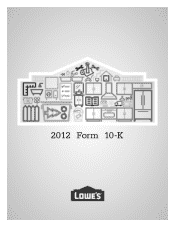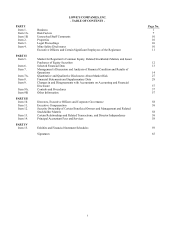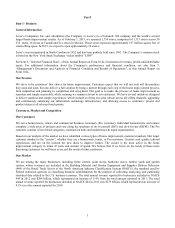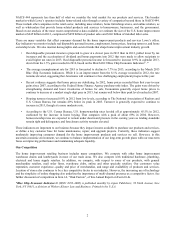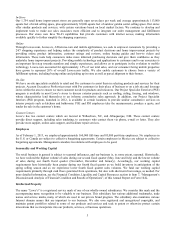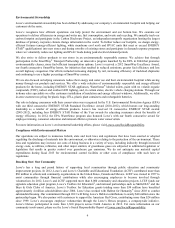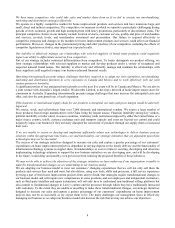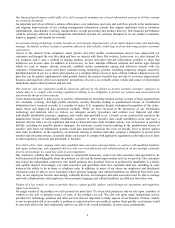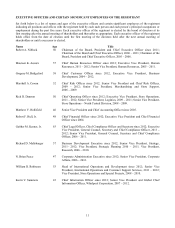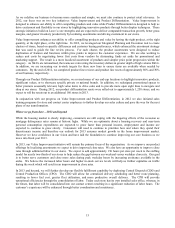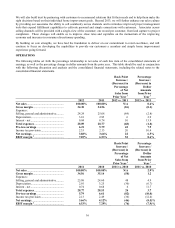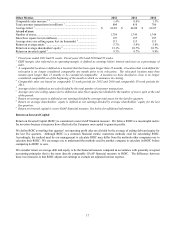Lowe's 2012 Annual Report Download - page 22
Download and view the complete annual report
Please find page 22 of the 2012 Lowe's annual report below. You can navigate through the pages in the report by either clicking on the pages listed below, or by using the keyword search tool below to find specific information within the annual report.8
We have many competitors who could take sales and market share from us if we fail to execute our merchandising,
marketing and distribution strategies effectively.
We operate in a highly competitive market for home improvement products and services and have numerous large and
small, direct and indirect competitors. The competitive environment in which we operate is particularly challenging during
periods of slow economic growth and high unemployment with heavy promotions, particularly of discretionary items. The
principal competitive factors in our industry include location of stores, customer service, quality and price of merchandise
and services, in-stock levels, and merchandise assortment and presentation. Our failure to respond effectively to
competitive pressures and changes in the markets for home improvement products and services could affect our financial
performance. Moreover, changes in the promotional pricing and other practices of our competitors, including the effects of
competitor liquidation activities, may impact our expected results.
Our inability to effectively manage our relationships with selected suppliers of brand name products could negatively
impact our ability to differentiate ourselves from competitors.
Part of our strategy includes continued differentiation from competitors. To better distinguish our product offering, we
form strategic relationships with selected suppliers to market and develop products under a variety of recognized and
respected national brand names. The inability to effectively and efficiently manage and maintain the relationships with
these suppliers could negatively impact our business plan and financial results.
Operating internationally presents unique challenges that have required us to adapt our store operations, merchandising,
marketing and distribution functions to serve customers in Canada and Mexico and to work effectively with our joint
venture partner in Australia.
A significant portion of our anticipated store growth over the next five years will be in Canada and Mexico. We are also in
a joint venture with Australia’s largest retailer, Woolworths Limited, to develop a network of home improvement stores for
consumers in Australia. Expanding internationally presents unique challenges that may increase the anticipated costs and
risks, and slow the anticipated rate, of such expansion.
If the domestic or international supply chain for our products is disrupted, our sales and gross margin would be adversely
impacted.
We source, stock, and sell products from over 7,000 domestic and international vendors. We source a large number of
those products from foreign manufacturers with China being the largest source. Financial instability among key vendors,
political instability or labor unrest in source countries, retaliatory trade restrictions imposed by either the United States or a
major source country, tariffs, currency exchange rates and transport capacity and costs are beyond our control and could
negatively impact our business if they seriously disrupted the movement of products through our supply chain or increased
their costs.
If we are unable to secure or develop and implement sufficiently robust new technologies to deliver business process
solutions within the appropriate time frame, cost and functionality, our strategic initiatives that are dependent upon these
technologies may not be successful.
The success of our strategic initiatives designed to increase our sales and capture a greater percentage of our customers’
expenditures on home improvement projects is dependent in varying degrees on the timely delivery and the functionality of
information technology systems to support them. Extended delays or cost overruns in securing, developing and otherwise
implementing technology solutions to support the new business initiatives we are developing now, and will be developing
in the future, would delay and possibly even prevent us from realizing the projected benefits of those initiatives.
We may not be able to achieve the objectives of the strategic initiatives we have underway if our organization is unable to
make the transformational changes we are undertaking in our business model.
We are adapting our business model to meet our customers’ changing expectations that we will not only sell them the
products and services they need and want, but also deliver, using new tools, skills and processes, a full service experience
by being a part of their home improvement projects from start to finish. Our strategies require transformational changes to
our business model and will require new competencies in some positions, and our employees and independent contractors,
such as third-party installers and repair technicians, will not only have to understand non-traditional selling platforms but
also commit to fundamental changes in Lowe’s culture and the processes through which they have traditionally interacted
with customers. To the extent they are unable or unwilling to make these transformational changes, our strategic initiatives
designed to increase our sales and capture a greater percentage of our customers’ expenditures on home improvement
projects may not be as successful as we expect them to be. The many challenges our management faces in effectively
managing our business as we adapt our business model also increase the risk that we may not achieve our objectives.


